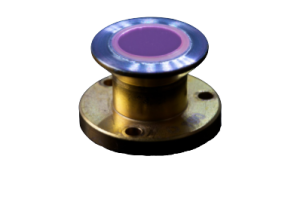Thin Disk Gain Media
Thin-disk lasers typically utilize ytterbium-doped yttrium aluminum garnet (Yb:YAG) crystal as the gain medium. Compared to neodymium-doped yttrium aluminum garnet (Nd:YAG) crystal, Yb:YAG displays several benefits. Firstly, it provides a shorter emission wavelength at around 1030 nm. Secondly, it has a lesser degree of quantum defect, which provides improved efficiency with regard to the conversion from pump photons to laser photons. Thirdly, Yb:YAG has a longer upper-state lifetime, which is beneficial for energy storage regarding Q-switching.
Furthermore, Yb:YAG thin disk gain media provides a larger gain bandwidth, which aids in short or ultra-short pulse generation (mode-locking). Another benefit derives from the ability to utilize higher doping concentrations. For example, the maximum dopant rate for neodymium is approximately 1.5%. Anything greater than around 1.5% doping with neodymium leads to excess material strain. However, the maximum dopant rate for ytterbium is much greater (up to ≈ 25%). A higher percentage of doping allows for stronger overall pump absorption. This increase does come at somewhat of a cost, as ytterbium is a quasi-three-level laser gain medium. This means it exhibits significant reabsorption at the laser wavelength, requiring greater intensities from the pump source. However, thin-disk lasers are particularly well suited for this situation.
Let Us Help
In conclusion, if you have any questions or would like some assistance, please contact us here. Furthermore, you can call us at 636.272.7227 to talk to a knowledgeable Product Manager. Alternatively, you can also use the filters on this page to assist in narrowing down the selection. Finally, head to our Knowledge Center with our Lasers 101 page and Blogs and Whitepapers pages for further, in-depth reading.
| Picture | Part Number | Type | Wavelength (nm) | Notes |
|---|---|---|---|---|

|
TD-XX-7X | Thin Disk Gain Media | 1030 | Yb-Doped YAG Thin Disks - 12/20 mm Dia. - 130/215 µm thick |
